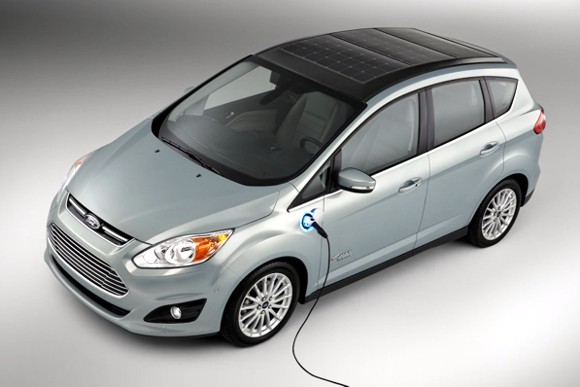As Ford continues the media tour of its new C-MAX Solar Energi concept car, the company says it will soon begin road testing the car in real-world scenarios. Ford says the outcome of those tests will help to determine the feasibility of the concept car as a production car.
 Ford C-MAX Solar Energi. Photo courtesy of CleanTechnica.com.
Ford C-MAX Solar Energi. Photo courtesy of CleanTechnica.com.
The concept car’s recent media tour has included the 2014 International CES, the 2014 Detroit Auto Show, and this month, the Geneva Motor Show.
Some new technologies had to be developed to even make the car possible as a concept car. The car works on a combination of solar energy that’s supplemented with plug-in power.
Ford said the car needs to get “a day’s worth of sunlight to deliver the same performance as a conventional C-MAX Energi plug-in hybrid.” The conventional C-MAX gets an EPA-estimated 108 MPGe city, a 92 MPGe highway, and a combined 100 MPGe.
Ford told the European market at the Geneva show that with a full charge the concept car is estimated to have a range of “up to 998 km (620 miles), including more than 30 electric-only kilometers (18 miles).” In addition, the company said that the car could “drive more than 30 km everyday on sun power” alone.
To build the technology needed to power the concept car, Ford worked in collaboration with solar manufacturer SunPower and researchers from the Georgia Institute of Technology (Georgia Tech).
Bert Bras, a professor with Georgia Tech’s Sustainable Design and Manufacturing lab worked closely with Ford and SunPower to develop a new lens technology “to amplify the sunlight needed to make a solar-powered hybrid feasible for daily use.”
Bras said that his lab helped develop the solar concentrators for the car ports. These concentrators use lenses similar to Fresnel lenses used to amplify the small light in lighthouse towers.
Bras explained that the special Fresnel lenses in the car-ports direct sunlight to the solar panels, acting like a magnifying glass and concentrating the energy. He added that the “grooves in the thin glass reflect the sunlight down to the car, boosting sunlight’s impact by a factor of eight.”
Bras talked more about how the car-port tracking system works, saying it “tracks the sun as it moves from east to west, drawing enough power from the sun daily to equal an 8 kilowatt hour battery charge.” He also revealed an interesting feature, that “the car has a self-parking feature that automatically moves the car to keep the sunlight focused on the rooftop panels.”
Bras also cautioned that the “charge is possible in the concept car, but much work remains before this off-the grid car can hit the streets. The next step will be to test it in practical situations.”
Ford says that among the benefits of the new technology would be for “places where the electric grid is underdeveloped, unreliable, and expensive to use.”
Reader comments and input are always welcomed!